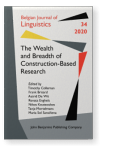Maximizing the explanatory power of constructions in Cognitive Construction Grammar(s)
This paper suggests two possible ways in which cognitively-oriented constructionist approaches (Cognitive Construction
Grammar, Radical Construction Grammar, and Embodied Construction Grammar) could enhance the explanatory power of constructions. First, the
anatomy of a construction should spell out how the morphosyntactic realizations of arguments are specifically mapped onto their inherent
semantico-pragmatic properties, while also including detailed information concerning illocutionary force, information structure, register,
politeness, etc. Second, it is argued that coercion should be best understood as a continuum allowing for varying degrees of
(in-)compatibility between the verb and the construction taken as a whole. Moreover, parameterization and linguistic cueing prove useful to
handle the dynamic interaction of the morphosyntactic, semantico-pragmatic, and discourse-functional hallmarks of constructions, including
those which invite metonymic inferencing.
Article outline
- 1.Introduction
- 2.On the formalization of information in the anatomy of constructions
- 3.On the dynamic interaction between coercion and figurative language
- 4.Closing remarks
- Acknowledgements
- Notes
-
References
